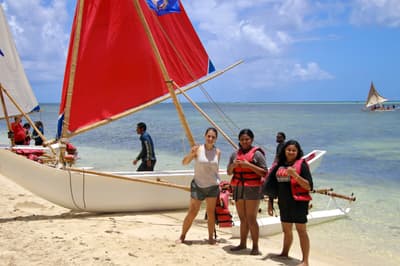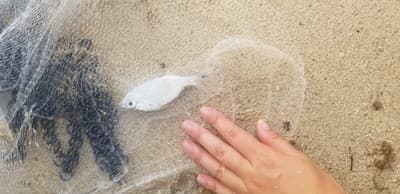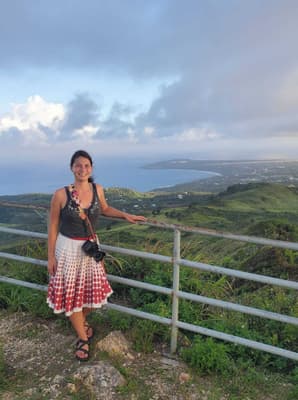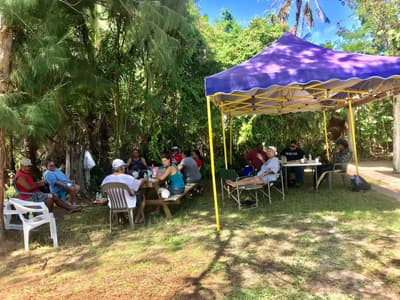From childhood Emily Wood (Indonesian 2018) was interested in understanding her CHamoru heritage. Growing up in a predominantly white area in the continental U.S., however, she had few opportunities. When Emily saw the opportunity to take CHamoru language classes online, she jumped at it. Since then, she’s delved deep into CHamoru cultural studies, traveling to Saipan to visit relatives and immerse herself in the local CHamoru community.
Emily’s exploration of her CHamoru identity has ignited a desire to contribute to the revitalization of indigenous language in the U.S. and abroad. Recently awarded the Payne Fellowship, Emily is pursuing a Masters in Global Human Development from Georgetown University and, upon graduation, will serve as a Foreign Service Officer at USAID. In her role as a Foreign Service Officer, Emily hopes to give a voice to communities with limited visibility and contribute to indigenous language and cultural conservation around the globe.
In recognition of Native American Heritage Month, Communications Officer, Rori DiFiore sat down with Emily to discuss her CHamoru language journey and why the revitalization of indigenous language around the world is so vital.
Rori DiFiore: I’d love to begin with you telling us a little about who the CHamoru people are.
Emily Wood: The CHamoru people are the indigenous people of the Mariana Islands, an island chain in the Pacific. One of the distinguishing features of CHamoru culture is seen in traditional houses made from latte stones. It is common to find thousand-year-old latte ruins throughout the Marianas. On the island of Tinian, you can find the highest latte ruins which are over 20 feet high.
RD: Can you tell us about your CHamoru background and how you’ve reconnected with it?
EW: My grandfather grew up on a ranch in Guam. At the time, speaking CHamoru was banned in public, including in schools. Those caught speaking CHamoru were fined or punished in other ways. Signs in stores read ‘English only, no other languages allowed.’ For my grandfather’s generation there was a powerful stigma against learning CHamoru. Because of this my mom never learned it. My grandfather’s generation didn’t want their children to be at a disadvantage for speaking CHamoru. I grew up in the continental U.S. in a predominately white area. I knew I was CHamoru but I didn’t grow up around it. When I was doing my bachelor's degree, I saw that there were online CHamoru classes offered through this organization called Håle' Para Agupa'. It opened up a whole new world to me. Learning more about our culture, our history. Since then, I’ve been delving deeper and deeper into it.


RD: How are you learning CHamoru? What resources exist for people interested in learning CHamoru?
EW: I’ve met people through the language classes offered through Håle' Para Agupa' and other means, and we’ve formed study groups to keep practicing. You can definitely see more interest beginning among younger generations because these people are in the diaspora, not on island. There are people like me who are younger, where only their grandparents can speak but they are now starting YouTube channels, blogs and advocacy groups to promote our language and cultural learning. But there are also older people whose parents used to speak but they never learned and now they are wanting to reconnect with that. Seeing the range of people all over the world wanting to learn is really encouraging. Now that I know a little bit, I try to speak with my grandpa on the phone. I don’t understand everything he is saying but I can understand things here and there. I can tell he’s really proud and excited.
RD: Why should people learn indigenous languages and support these efforts?
EW: Language is so closely linked with identity. Even if it’s not a part of your personal identity and you are learning someone else’s indigenous language, there are many things you can learn about a culture from the language. In CHamoru the grammar structure and the way you talk about people is very different from English. You get a glimpse into how people saw each other and the land thousands of years ago. CHamoru people called themselves ‘Taotao tåno', which means people of the land.
Similar to Inuit languages which have dozens of words for snow, in CHamoru there are many words for the different parts of the coconut tree. Because you can do something with every single part. In English, we have the coconut tree, leaves and fruit and that’s all we can do with the coconut. Not in CHamoru.
RD: That is so telling. It shows their resourcefulness and deep appreciation for our environment and what it produces. You mentioned recently traveling to Saipan to visit family. What was it like speaking CHamoru with family and local people?
EW: Well…it definitely wasn’t like my CLS experience. I was able to speak with people here and there, different elders which was very interesting. I still wasn’t completely immersed like I was hoping to be. Because my cousins and younger generations there haven’t learned, it was mostly elders and older people I was speaking with. That experience did open doors into learning about the culture. Elders shared with me different stories and were very friendly in helping me speak. There is still so much to learn and it's hard when I only have classes a couple times a week.
RD: What do efforts to revitalize indigenous languages look like?
EW: I recently attended an indigenous language revitalization conference. It was both encouraging and so sad. There are so many people who are doing great work and it’s inspiring but at the same time there are people who are saying our last native speaker has just died. There are other languages where there might not have been any native speakers in one generation but people our age are teaching their children so their children are now native speakers. It’s skipping a generation but coming back because there are people passionate about keeping these languages alive.


RD: What are your career plans and how do you hope to contribute to awareness of the issues facing indigenous people?
EW: I am in graduate school right now as part of the Payne Fellowship Program studying international development. After I graduate, I will go work as a foreign service officer at USAID. I have seen many similarities between indigenous people in Guam, including my own family, and native people all over the world. There is a shared history of colonization, forced assimilation, language and culture loss. This translates to lower levels of development and fewer economic opportunities. I think there’s more we can do. Indigenous people are often overlooked and when they are accounted for or included, it’s by people who are not indigenous. They are not included in the processes that so often impact them directly. As someone with indigenous background, although my experience is vastly different than other people’s, I feel like I can bring these perspectives and hopefully work with people to emphasize that self-reliance.
RD: What would you like people to know about CHamoru people? How can we better support indigenous people?
EW: CHamoru people are extremely resilient. After being colonized for over 500 years in Guam, we’ve retained a lot of our culture and language even after all this time, and we are still in the process of reclaiming it. And even though we are resilient people, it is taxing. History has happened to us, and we haven’t had so much of a role in it. I think we can change that. By including more indigenous people in leadership roles, spearheading revitalization of indigenous language and culture, incorporating indigenous knowledge. By including us and really listening to us. That’s a starting point.


